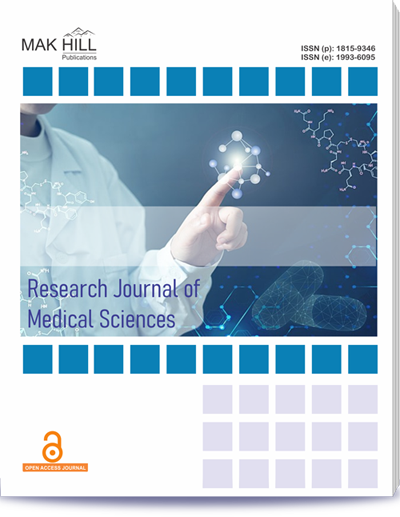
Research Journal of Medical Sciences
ISSN: Online 1993-6095ISSN: Print 1815-9346
Abstract
HbA1c, the most abundant minor Hb component in human erythrocytes, is formed by the condensation of glucose with the N- terminal amino groups of the beta chains of Hb-A as both glucose and Hb are found in large quantities in the RBCs. HbA1c is slowly formed during the 120-day lifespan of the erythrocyte and therefore the concentration of HbA1c would be higher in older red cells. Hence, it reflects the glycemic control for a period of 6-10 weeks. It is aimed to prospectively evaluate the association between HbA1c levels measured in all trimesters and the birth weight of the newborn. The present study was a case control study with control matched to cases for gestational age and parity study. This Study was conducted from March 2020 to September 2021(18 months) at Department of IPGME and R and SSKM Hospital. We found that in GDM Diagnosis, the mean HbA1C level 1st Trimester (Mean±SD) of patients was 5.1960±0.1969 and in Normal Diagnosis, the mean HbA1C level 1st Trimester (Mean±SD) of patients was 5.1040±0.3084, which was not statistically significant (p = 0.0785). We also found that in GDM Diagnosis, the mean HbA1C level 2nd Trimester (Mean±SD) of patients was 6.1900±0.2178 and in Normal Diagnosis, the mean HbA1C level 2nd Trimester (Mean±SD) of patients was 5.4920±0.2702 which was statistically significant (p<0.0001). It was found that in GDM Diagnosis, the mean HbA1C level 3rd Trimester (Mean±SD) of patients was 6.8940±0.2583 and in Normal Diagnosis, the mean HbA1C level 3rd Trimester (Mean±SD) of patients was 5.5320±0.2004 which was statistically significant (p<0.0001). We also observed that the mean period of gestation at which GDM patients delivered was 37.2000 1.0583 as compared to NORMAL patients with mean period of gestation of delivery being 39.2000 0.9081 and this was statistically significant. In our study HbA1C level 1st Trimester had no significant difference with Birth weight kg group. We also found that HbA1C level at 2nd Trimester and at 3rd Trimester was significantly increased in GDM patients who also had increased Birth weight as compared to NORMAL patients. We concluded that, there is no simple relationship between maternal glycemic status in 1st Trimester and birth weight, but there seems to be an inverse relationship between second and third trimester glycemic control and standardized birth weight. There is no simple relationship between maternal glycaemic status and birth weight, but there appears to be a paradoxical inverse relationship between pre-pregnancy glycaemic control and standardized birth weight. This might implicate that for prevention of congenital malformations and macrosomia in pregnant GDM women there should be a good glycaemic control prenatally as well as intranatally.
How to cite this article:
Geetika Gupta, Beauty Gupta and Binod Kumar Gupta. A Study to Assess the Relation Between Maternal HbA1c Levels in First Trimester and Birth Weight of the Baby.
DOI: https://doi.org/10.36478/10.59218/makrjms.2023.8.92.98
URL: https://www.makhillpublications.co/view-article/1815-9346/10.59218/makrjms.2023.8.92.98